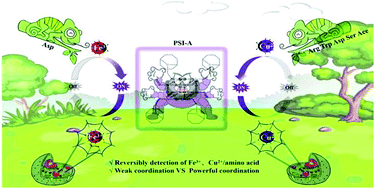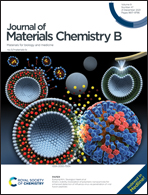The diversity of the coordination bond generated a POSS-based fluorescent probe for the reversible detection of Cu(ii), Fe(iii) and amino acids†
Abstract
In recent years, it has been found that Cu2+, Fe3+, and amino acids play an irreplaceable and subtle role in organisms and have attracted the considerable attention of many researchers. Therefore, it is vital to design visual indicators to reveal the relationships between metal ions and amino acids. However, there have been few reports on this vigorous subject. Fortunately, based on the different coordination effects between metal ions and boron groups, we have designed an accessible fluorescent probe (PSI-A). Borane was introduced as an ion-sensitive group to form a novel POSS-based fluorescent probe, which achieves fascinating performance, in situ dynamic multiple detection, excellent photostability, and enervative biological toxicity. PSI-A exhibited predominant selectivity and sensitivity to Cu2+/amino acids and Fe3+/amino acids sequence reactions in HepG2 cells and zebrafish. The fluorescence of PSI-A was quenched by Cu2+, which can be recovered by adding Asp, Ser, Arg, Ace or Trp. Additionally, the fluorescence of PSI-A quenched by Fe3+ can be restored after adding Asp. PSI-A is available to monitor Cu2+/amino acids and Fe3+/amino acids sequence reactions and can be repeated for at least three consecutive cycles without a fatigued performance. Therefore, this multifunctional fluorescent probe may have prospective application potentials in the biological field.



 Please wait while we load your content...
Please wait while we load your content...